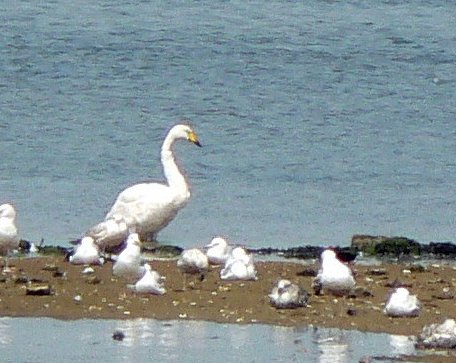Whooper Swan Cygnus cygnus
|
International
Now widely regarded as a separate species from its North
American counterpart (Trumpeter Swan Cygnus buccinalor), so
monotypic, as validity of islandicus is uncertain.
Estimated 180,000 adult individuals; nests on islands or adjacent shallow waters with emergent vegetation, bogs and marshland in afforested tundra and taiga zones from Iceland to eastern Russia, arriving on breeding grounds generally in the second half of May, Virtually wholly migratory and influenced by freshwaters freezing over, they arrive at wintering grounds in Oct/Nov in lowland Europe and eastern Asia, favouring marshlands, floodplains, fresh and brackish lakes, estuaries, sheltered coasts and increasingly on lowland agricultural fields. Departure from wintering grounds is from mid-Mar to early-May
††.Europe and Great Britain
Its susceptibility to particularly harsh winters is not well understood, but GB may play host to extra visitors that normally winter in Germany and Denmark, presumably first moving to the Low Counties and then into GB, if severe enough.
Devon
Dawlish Warren
There are 11 records involving at least 19 birds:
|
23 Jan 1893 31 Jan 1954 11 Jan - 15 Mar 1970 17 Dec 1973 02 & 08 Jan 1974 14 Jan 1981 15 Oct 2000 11 Jan 2002 05, 07 & 09 Nov 2002 10 Jun 2007 27 Jan 2008 |
a young female shot in the Bight off
Exmouth 23 Jan 1893” † “eight including four adults seen to leave lower estuary in a southerly direction” (R.G. Adams) † one (R.G. Adams et al) one in the saltmarsh (B Gregory, A Rosier) no details for sightings, except from “Exe Est, wintering birds stayed to the end of Feb" † three (A Rosier) one adult with Mute Swans in Shutterton Creek (K. Rylands et al) one (JEF) one adult, roosted in Shutterton Creek leaving early each morning (JEF et al) one in estuary behind Golf Course (D Smallshire) one flew S down the estuary before landing on sea (LC et al) |
Half of records have occurred within only the past decade, compared with the first five records, which took nearly a century to appear. This is likely a combined reflection on increased observer effort and that it has genuinely become more frequently seen in the SW since the mid-20th century. Although most likely of Icelandic origin, the increasing Fenno-Scandinavian and W Russian breeding population, and increasing tendency to immigrate from usual wintering grounds on the Continent could be an alternative source of records here†.
Seven records refer to only brief visits, but three singles have remained longer, one for two months. The only year with two records (2002) coincided with Devon’s highest annual tally of individuals.
The mid-summer record in 2007 was probably the same adult present on the Otter Estuary 26 May to 19 Oct†.


10/06/2007 © Dave
Smallshire
Updated 11/08/2013
